Henry and Henry's Amazing Adventures in Transylvania
/ This picture and all others included here are taken by my son, Henry Jenkins IV. It was just a little past midnight when our airplane landed in Transylvania and our taxi made its way to our Inn at the heart of Cluj Napoca. It was, alas, not a particularly dark or particularly stormy night, and the locals in the Inn did not stare it me strangely, did not offer me crucifix or garlic necklaces, but otherwise, this was the fantasy of a boy who grew up reading Famous Monsters of Filmland and reading about the "Historic Dracula" come true. When I was asked to come to Transylvania in the heart of October to speak about transmedia/intermedia relations, it was too good to be true and even though doing so has disrupted my term and left me jet lagged for more than a week now, I have no regrets. This was a fascinating trip -- a visit to a homeland of the imagination, one where one constantly catches glimpses of some of the elements upon which Bram Stoker and Hollywood built their fantasies, as long as you keep in mind that the Irish-born Stoker never got closer to this place that prying Romanian expats with drinks and sitting in the British Library, and as long as you keep in mind that Bela Lugosi was Hungarian, not Romanian, and... Above, you see an image of Bran Castle, which is marketed to tourists as "Castle Dracula," and which suspended disbelief will allow to play that part in our travel adventure. This castle looks somewhat like the one depicted in the 1930 Universal Dracula film (see this frame grab).
This picture and all others included here are taken by my son, Henry Jenkins IV. It was just a little past midnight when our airplane landed in Transylvania and our taxi made its way to our Inn at the heart of Cluj Napoca. It was, alas, not a particularly dark or particularly stormy night, and the locals in the Inn did not stare it me strangely, did not offer me crucifix or garlic necklaces, but otherwise, this was the fantasy of a boy who grew up reading Famous Monsters of Filmland and reading about the "Historic Dracula" come true. When I was asked to come to Transylvania in the heart of October to speak about transmedia/intermedia relations, it was too good to be true and even though doing so has disrupted my term and left me jet lagged for more than a week now, I have no regrets. This was a fascinating trip -- a visit to a homeland of the imagination, one where one constantly catches glimpses of some of the elements upon which Bram Stoker and Hollywood built their fantasies, as long as you keep in mind that the Irish-born Stoker never got closer to this place that prying Romanian expats with drinks and sitting in the British Library, and as long as you keep in mind that Bela Lugosi was Hungarian, not Romanian, and... Above, you see an image of Bran Castle, which is marketed to tourists as "Castle Dracula," and which suspended disbelief will allow to play that part in our travel adventure. This castle looks somewhat like the one depicted in the 1930 Universal Dracula film (see this frame grab). Of course, even before we get there, you will already notice that the mountains here are much more rounded, foothills really, as opposed to the jagged mountains depicted in the film.
Of course, even before we get there, you will already notice that the mountains here are much more rounded, foothills really, as opposed to the jagged mountains depicted in the film.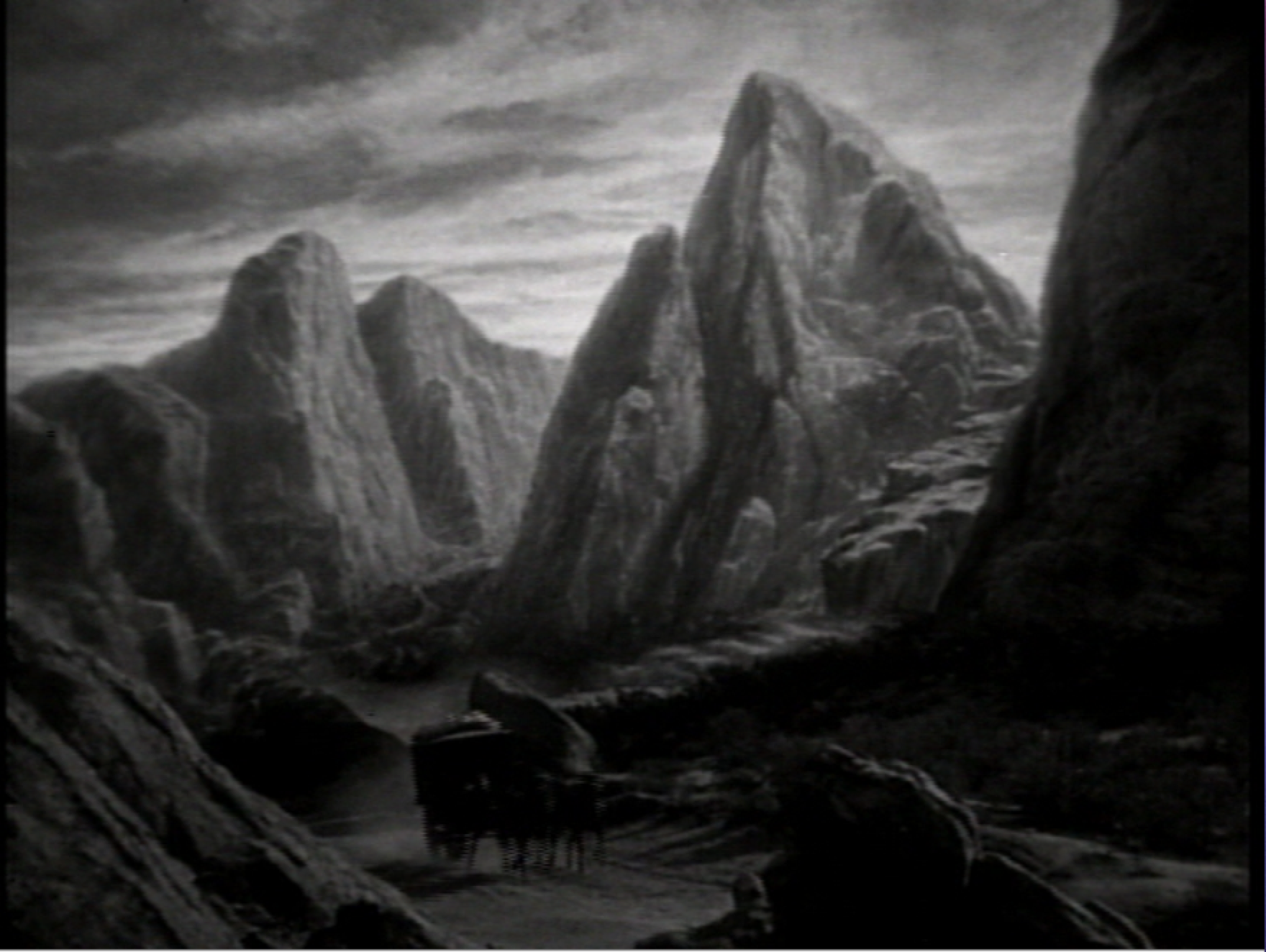
 You can find somewhat more jagged sections of the Carpathian Mountains elsewhere in the countryside, as my son discovered when he was out of exploring by car later in the trip.
You can find somewhat more jagged sections of the Carpathian Mountains elsewhere in the countryside, as my son discovered when he was out of exploring by car later in the trip. 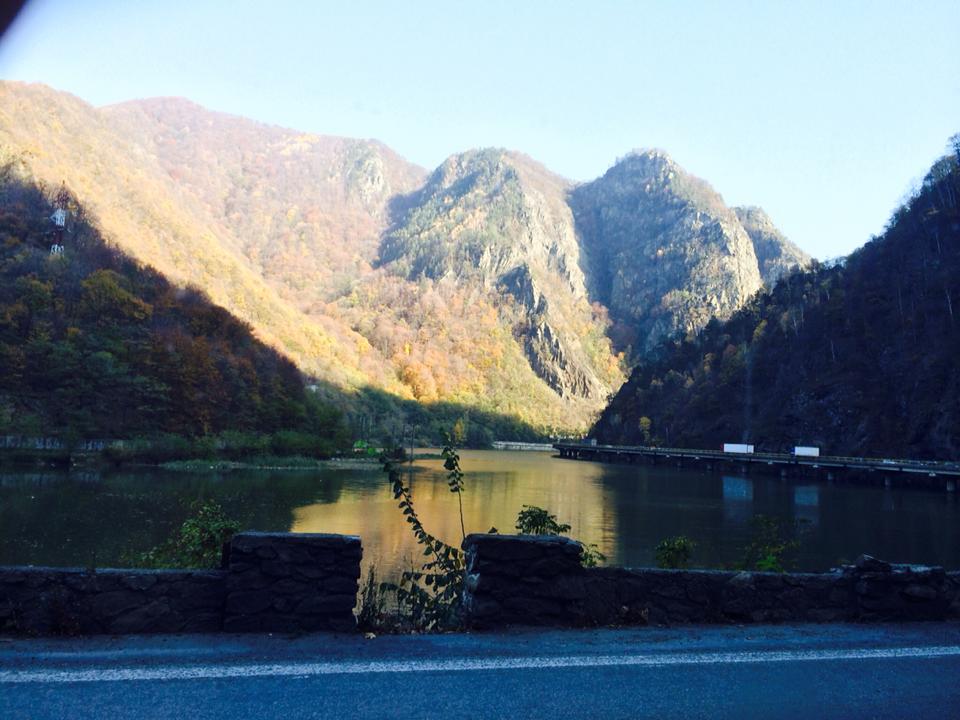 The second thing you will notice, which also helps to dislodge our fantasies, is that the castle, in the inside, is much more cramped than the one depicted by Hollywood. The staircase is much narrower and would not have allowed for Dracula's grand sweeping entrance.
The second thing you will notice, which also helps to dislodge our fantasies, is that the castle, in the inside, is much more cramped than the one depicted by Hollywood. The staircase is much narrower and would not have allowed for Dracula's grand sweeping entrance. 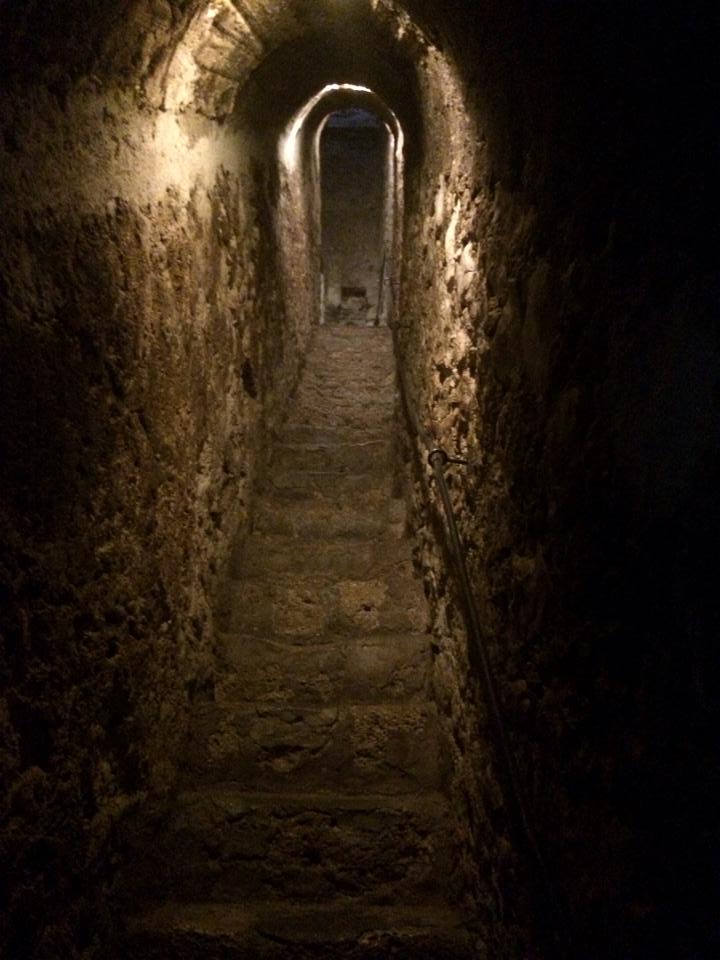
In many ways, the castle depicted in the Universal film is a bit like the TARDIS-- bigger on the inside than in the outside. As a matter of historic record, this was probably not the castle Stoker had in mind when he imagined Dracula's place. There was a wooden castle on this location as early as 1212 built by the Teutonic Knights, destoryed and rebuilt many times through the years; Vlad Tepes did have some loose association with this castle. But, the current castle was strongly associated with the Romanian Royal family in the early 20th century and only loosely tied to the historic or mythic Dracula figure. Of course, none of this stops western tourists from pretending that they are visiting THAT Castle Dracula. It certainly sent a chill down my spine when we passed -- like Jonathon Harker -- through the doorway into the castle. 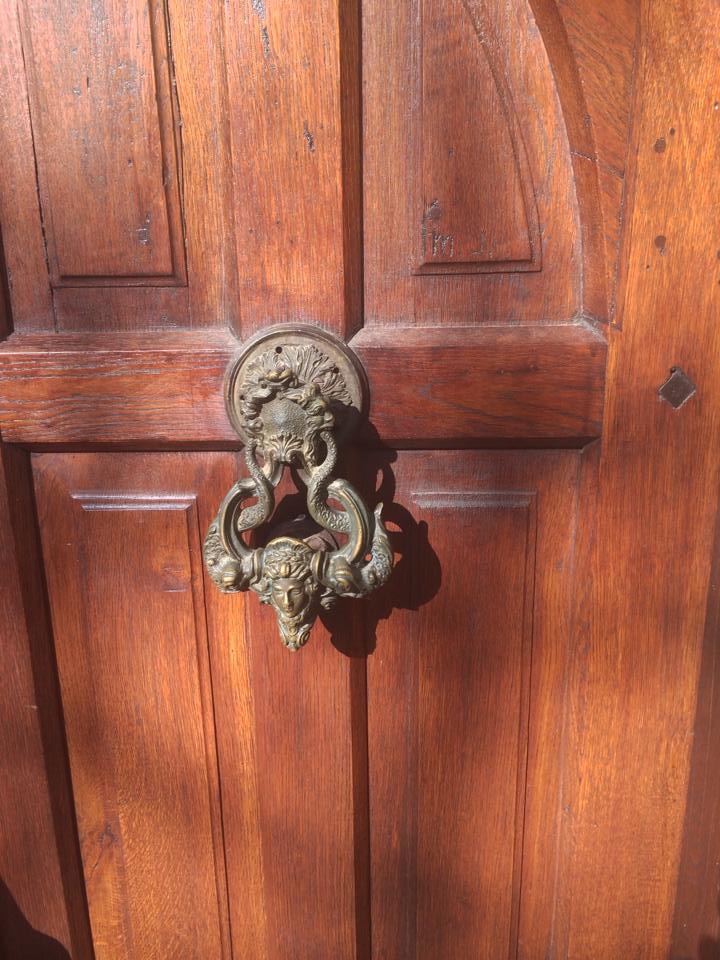 The heritage foundation that maintains and operates the castle wants to play it both ways. Inside the a Castle, there is a gift shop which sells only historically accurate materials -- focused on Vlad Tepes (Vlad Dracula) and the Romanian Royals -- where-as just outside the gates of the Castle, you can buy totally trashy Dracula-head mugs with blood dripping from their fangs or T-Shirts celebrating Dracula, Prince of Darkness and you can visit a cheesy haunted castle attraction with guys in rubber monster masks chasing around the tourists. And inside the castle, there are posters talking about both the Historic and Mythic Dracula and there are horror-fan friendly displays of old school torture instruments, like this Iron Maiden.
The heritage foundation that maintains and operates the castle wants to play it both ways. Inside the a Castle, there is a gift shop which sells only historically accurate materials -- focused on Vlad Tepes (Vlad Dracula) and the Romanian Royals -- where-as just outside the gates of the Castle, you can buy totally trashy Dracula-head mugs with blood dripping from their fangs or T-Shirts celebrating Dracula, Prince of Darkness and you can visit a cheesy haunted castle attraction with guys in rubber monster masks chasing around the tourists. And inside the castle, there are posters talking about both the Historic and Mythic Dracula and there are horror-fan friendly displays of old school torture instruments, like this Iron Maiden.  We found a similar mix of the historic and mythic, the discrete and the tasteless, everywhere we went in the country where Dracula is concerned. For example, consider this attraction in Sighisoara. It is well established that Vlad Dracul (The Dragon) spent a few years in this town, but it is not proven that his son, the more famous Vlad Dracula, ever lived here, let alone being born here. But, this dubious historic claim exists alongside a fairly flamboyant appeal to the legacy of Bela Lugosi.
We found a similar mix of the historic and mythic, the discrete and the tasteless, everywhere we went in the country where Dracula is concerned. For example, consider this attraction in Sighisoara. It is well established that Vlad Dracul (The Dragon) spent a few years in this town, but it is not proven that his son, the more famous Vlad Dracula, ever lived here, let alone being born here. But, this dubious historic claim exists alongside a fairly flamboyant appeal to the legacy of Bela Lugosi.
Given how often Transylvania appears in our culture associated with the monstrous, a fairly routine site here -- a pretty standard hotel complex -- can nevertheless get linked in our minds to its Hollywood counterparts.
Of course, we discovered definitively that there are no Monsters in Transylvania. My son is an energy drink fiend but all he could find were Red Bulls. :-) That said, I should share with you a spooky thing that happened while we were visiting the castle. We were driving back to Brasov along a narrow two lane highway that lead through the Romanian countryside on a lovely fall day. Suddenly, the GPS rather insistently is directing us off the main highway onto a much smaller road which runs through a small rural town. Our progress gets stopped by a funeral procession -- people in black, carrying large crosses, and lugging the coffin along the narrow, winding streets. After a while, we realize that the GPS is spinning us around in circles and taking us into ever more remote sections of town, so we decided to head back to the main highway. By the time we get there, we are hopelessly disoriented and so we follow the GPS directions back along the highway. Suddenly, we realize that for no particular reason, the GPS has taken us back to Bran Castle, rather than onward to our previously programmed location. I am now thoroughly convinced that the ability to control GPS systems is now a power associated with vampires in the 21st century alongside the ability to turn into a bat or a wolf or a cloud of mist or to command hordes of rats. It makes sense that Dracula would want to keep up with the times, right? Even without Dracula taking over your GPS, driving in Romania can be a white knuckle experience. Drivers are aggressive, speed limits are "optional," and we remained utterly baffled about how right-away worked on the round-abouts except that whatever we did was wrong. I was especially amused about a GPS which doggedly told you that you were over the speed limit if you were anywhere close to the speed limit and then kept its mouth shut if you went racing well past it. In many ways, Romania is a country where the old world and the new meet -- a thoroughly modern, post-Communist society with a sophisticated education system that thoroughly embraces forms of multiculturalism that would put most U.S. schools to shame but also one where it is not at all unusual to see wooden horse-drawn carts alongside the highway, where live stock runs free range and
thus cars get stopped by lines of cattle crossing the road, and where we spotted shepherds attending their flocks.  For us, a highlight of the trip was our chance to visit Viscri, a remote farm village, which was recently discovered by Prince Charles and where he has a little get-away place. Forget about the royals -- I have limited patience with the romance surrounding Europe's aristocracy. But, I share Charles's fascination with the traditional lifestyle represented here. To get to this place, you drive 10 miles or more down rambling country roads -- sometimes paved, often dirt, and even more often some place in between -- and past cottages where people do wander our and stair at you as you drive past.
For us, a highlight of the trip was our chance to visit Viscri, a remote farm village, which was recently discovered by Prince Charles and where he has a little get-away place. Forget about the royals -- I have limited patience with the romance surrounding Europe's aristocracy. But, I share Charles's fascination with the traditional lifestyle represented here. To get to this place, you drive 10 miles or more down rambling country roads -- sometimes paved, often dirt, and even more often some place in between -- and past cottages where people do wander our and stair at you as you drive past. 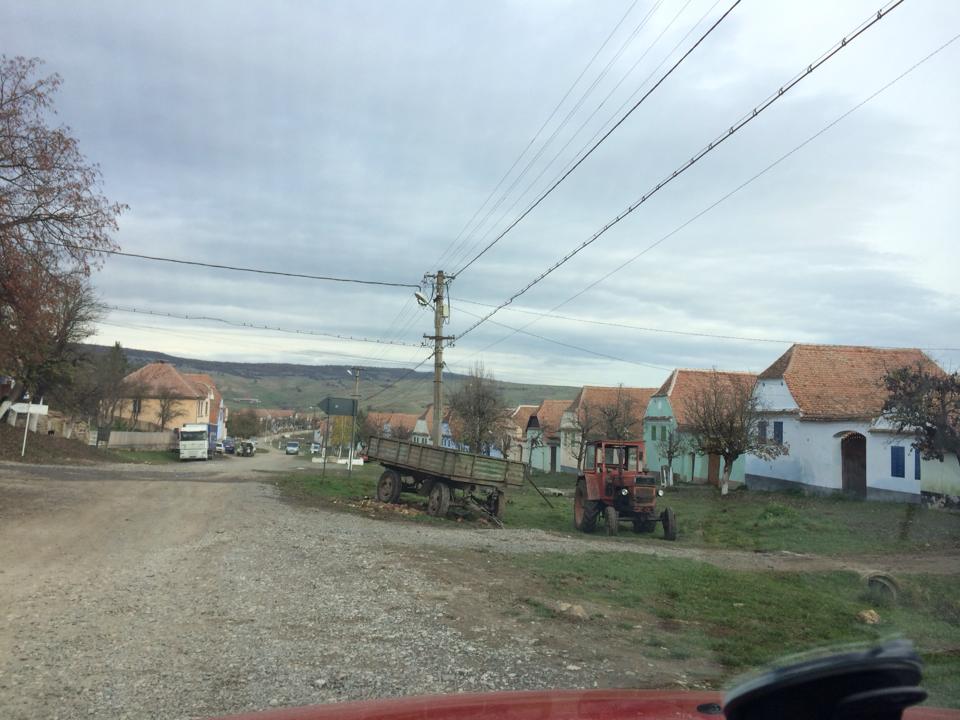 We were invited to dinner (for payment) at the home of a local farm woman who cooked us up a robust meal of traditional peasant food, which was the very essence of the "slow food" movement -- all locally grown and fresh tasting. A local high school aged girl took us around the village, showing us the country church which has served this town for several hundred years.
We were invited to dinner (for payment) at the home of a local farm woman who cooked us up a robust meal of traditional peasant food, which was the very essence of the "slow food" movement -- all locally grown and fresh tasting. A local high school aged girl took us around the village, showing us the country church which has served this town for several hundred years. 
 And we were taken on a cross-country ride on one of those horse drawn carts we had driven past many times along our route. The horse led us along sloping mist-shrouded pastures and through hardwood forests, red and orange with Autumn colors. A newly born colt raced alongside us much of the way.
And we were taken on a cross-country ride on one of those horse drawn carts we had driven past many times along our route. The horse led us along sloping mist-shrouded pastures and through hardwood forests, red and orange with Autumn colors. A newly born colt raced alongside us much of the way. 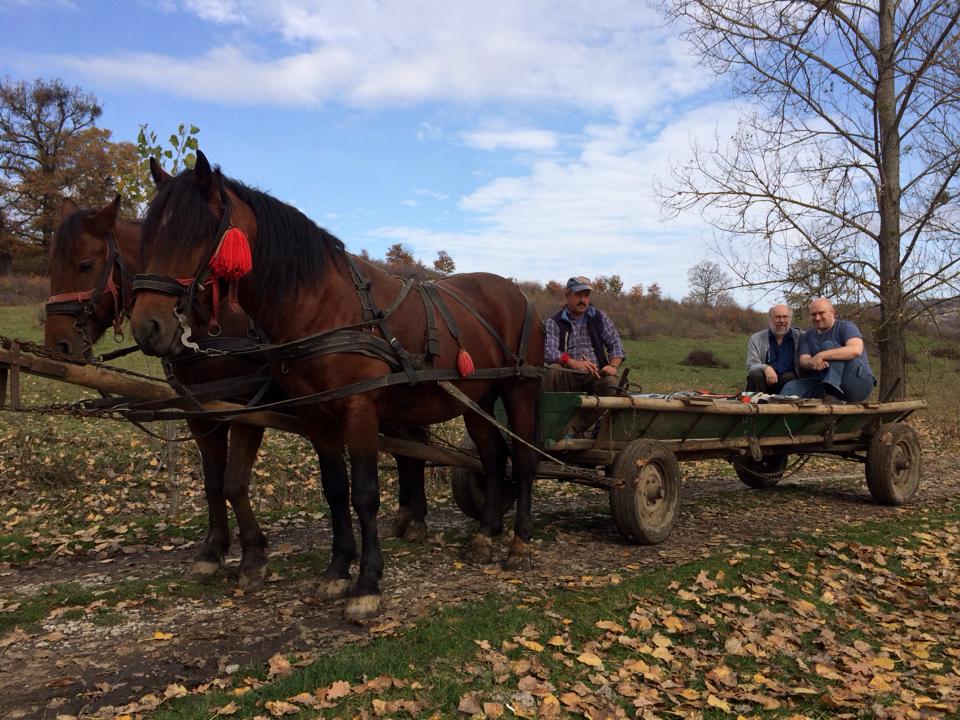 My son was especially intrigued by our visit to a couple who lived in a cart and worked to prepare charcoil (all very traditional except for the boom box which was playing La Bomba as we stopped by.)
My son was especially intrigued by our visit to a couple who lived in a cart and worked to prepare charcoil (all very traditional except for the boom box which was playing La Bomba as we stopped by.) 

 Traveling on his own, my son -- continuing to travel as I got engrossed into the conferences I was addressing -- visited Astra, which he described as a living history museum, dedicated to preserving traditional peasant culture in Romania. Here are a few of the images he's shared with me.
Traveling on his own, my son -- continuing to travel as I got engrossed into the conferences I was addressing -- visited Astra, which he described as a living history museum, dedicated to preserving traditional peasant culture in Romania. Here are a few of the images he's shared with me. 
 But, in many ways, Viscri, which still functions as a farming community as it has for many years, is itself a "living history" museum -- off the beaten path and a perfect way to learn more about this way of life. As we went from town to town, we saw many signs of the history of conflicts which defined this region across many centuries. As a territory which was often raided by its more powerful neighbors, almost every major town and city we visited was structured around a medieval fortress model, where the cultural geography was defined by what was or was not inside the gates and where at the very center was often the church and the school, the two most cherished institutions, and the place where people flocked for protection in the midst of a civic emergency. For example, you see in these images below some of the protective walls, a staircase which students climbed everyday to the top of the fortress to go to school, and a graveyard that is adjacent to the local church, all within Sighisoara, a city where they still fully use the space within the old fortifications.
But, in many ways, Viscri, which still functions as a farming community as it has for many years, is itself a "living history" museum -- off the beaten path and a perfect way to learn more about this way of life. As we went from town to town, we saw many signs of the history of conflicts which defined this region across many centuries. As a territory which was often raided by its more powerful neighbors, almost every major town and city we visited was structured around a medieval fortress model, where the cultural geography was defined by what was or was not inside the gates and where at the very center was often the church and the school, the two most cherished institutions, and the place where people flocked for protection in the midst of a civic emergency. For example, you see in these images below some of the protective walls, a staircase which students climbed everyday to the top of the fortress to go to school, and a graveyard that is adjacent to the local church, all within Sighisoara, a city where they still fully use the space within the old fortifications. 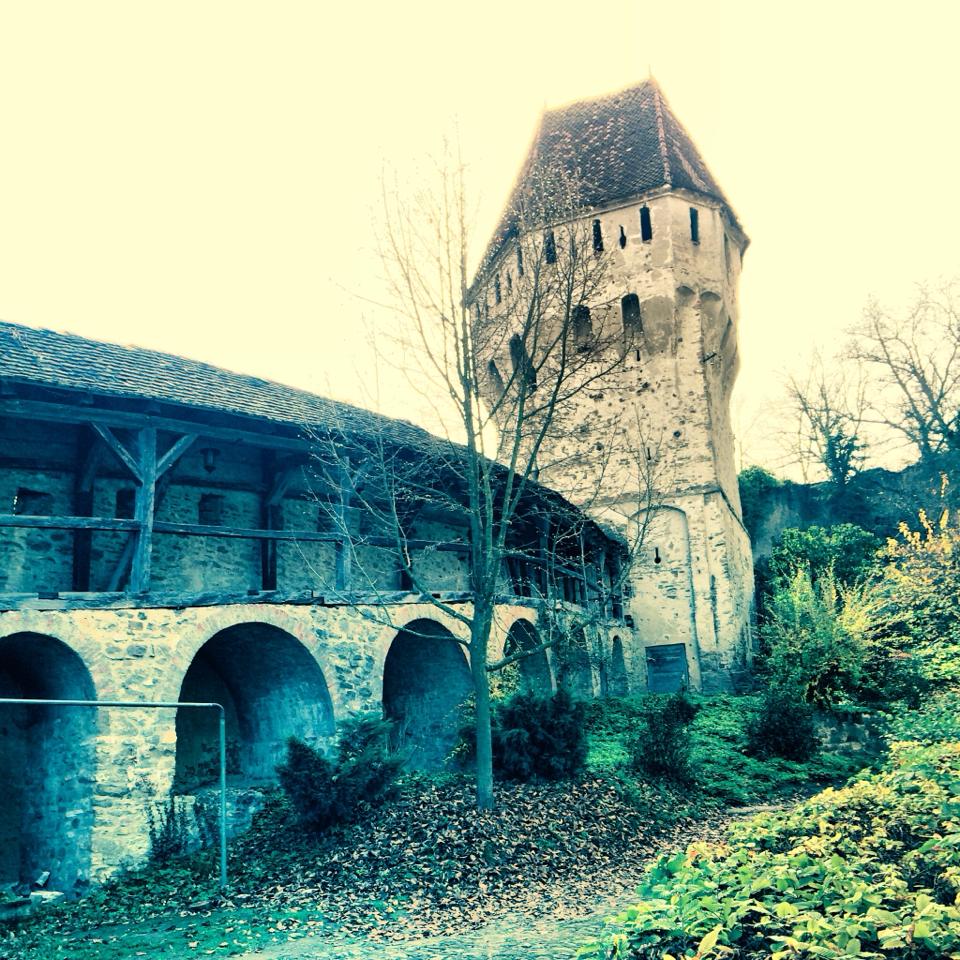

 About midway through the trip, father and son split apart. My son continued to explore Romania, including a visit to Bucharest, the capital city of Romania, where-as I went back to participate in the conferences which paid my way over there. I spoke first at a conference on Convergence hosted by the Journalism program at Babeş-Bolyai University where I shared some of my current work on youth, new media, and activism. I met Peter Gross, a Romanian-born Journalism Scholar, who has spent much of his life in the United States, now teaches at the University of Tennessee. Gross was described to me as a key figure in helping Romania to develop a free press following the fall of communism. And the program here has proven to be an enormous success in training communication professionals (some of whom have gone on to key positions within the Romanian government). This conference was celebrating their 20th anniversary as a journalism school. My second speaking gig was a keynote address to the Conference of the International Society of Intermedial Studies, which was hosted by Sapientia Hungarian University of Transylvania and where I spoke about world-building in relation to the historical evolution of L. Frank Baum's Oz. Here, you see me interacting with a fellow keynote speaker, the noted narrative theorist Laurie-Marie Ryan. Ryan delivered a talk which dissected and reconstructed the concept of transmedia narrative, strongly focused on my own work. Her title, "Transmedia Storytelling -- Myth or Reality?" left me a bit apprehensive, since given that framing, "myth" was the most likely answer. She argues that there has still been relatively few examples of fully achieved transmedia, at least as defined in Convergence Culture, but ultimately she seemed engaged and sympathetic to the idea.
About midway through the trip, father and son split apart. My son continued to explore Romania, including a visit to Bucharest, the capital city of Romania, where-as I went back to participate in the conferences which paid my way over there. I spoke first at a conference on Convergence hosted by the Journalism program at Babeş-Bolyai University where I shared some of my current work on youth, new media, and activism. I met Peter Gross, a Romanian-born Journalism Scholar, who has spent much of his life in the United States, now teaches at the University of Tennessee. Gross was described to me as a key figure in helping Romania to develop a free press following the fall of communism. And the program here has proven to be an enormous success in training communication professionals (some of whom have gone on to key positions within the Romanian government). This conference was celebrating their 20th anniversary as a journalism school. My second speaking gig was a keynote address to the Conference of the International Society of Intermedial Studies, which was hosted by Sapientia Hungarian University of Transylvania and where I spoke about world-building in relation to the historical evolution of L. Frank Baum's Oz. Here, you see me interacting with a fellow keynote speaker, the noted narrative theorist Laurie-Marie Ryan. Ryan delivered a talk which dissected and reconstructed the concept of transmedia narrative, strongly focused on my own work. Her title, "Transmedia Storytelling -- Myth or Reality?" left me a bit apprehensive, since given that framing, "myth" was the most likely answer. She argues that there has still been relatively few examples of fully achieved transmedia, at least as defined in Convergence Culture, but ultimately she seemed engaged and sympathetic to the idea. This conference brought together many bright young scholars from across contemporary Europe -- including a very impressive delegation from Serbia and the other Balkan Countries -- and some from the Americas or Asia, who were seeking to better understand points of intersection between different kinds of media. I was highly impressed by the caliber of work I saw over-all: the approaches taken ranged widely across different disciplinary, methodological, and theoretical traditions, across different historical periods and national contexts, across different kinds of media objects (from cave paintings to digital projections), and across cultural divides (high and low). In many ways, it reminded me of the Media in Transition Conference at MIT, and I left hoping to see more cross-over between the two events in the future. This was the conference's first year as an officially international gathering, having been started as the Nordic Society for Intermedial Research, and gathering so many people from beyond Scandanavia that they decided to re-invent themselves. The discussions were intense and constructive, and it was great to see how much they nurtured graduate students and junior scholars, with a higher than average number of participants sharing some of their first scholarly presentations. Here you see me with a group of scholars who I ended up spending a great deal of time.
This conference brought together many bright young scholars from across contemporary Europe -- including a very impressive delegation from Serbia and the other Balkan Countries -- and some from the Americas or Asia, who were seeking to better understand points of intersection between different kinds of media. I was highly impressed by the caliber of work I saw over-all: the approaches taken ranged widely across different disciplinary, methodological, and theoretical traditions, across different historical periods and national contexts, across different kinds of media objects (from cave paintings to digital projections), and across cultural divides (high and low). In many ways, it reminded me of the Media in Transition Conference at MIT, and I left hoping to see more cross-over between the two events in the future. This was the conference's first year as an officially international gathering, having been started as the Nordic Society for Intermedial Research, and gathering so many people from beyond Scandanavia that they decided to re-invent themselves. The discussions were intense and constructive, and it was great to see how much they nurtured graduate students and junior scholars, with a higher than average number of participants sharing some of their first scholarly presentations. Here you see me with a group of scholars who I ended up spending a great deal of time.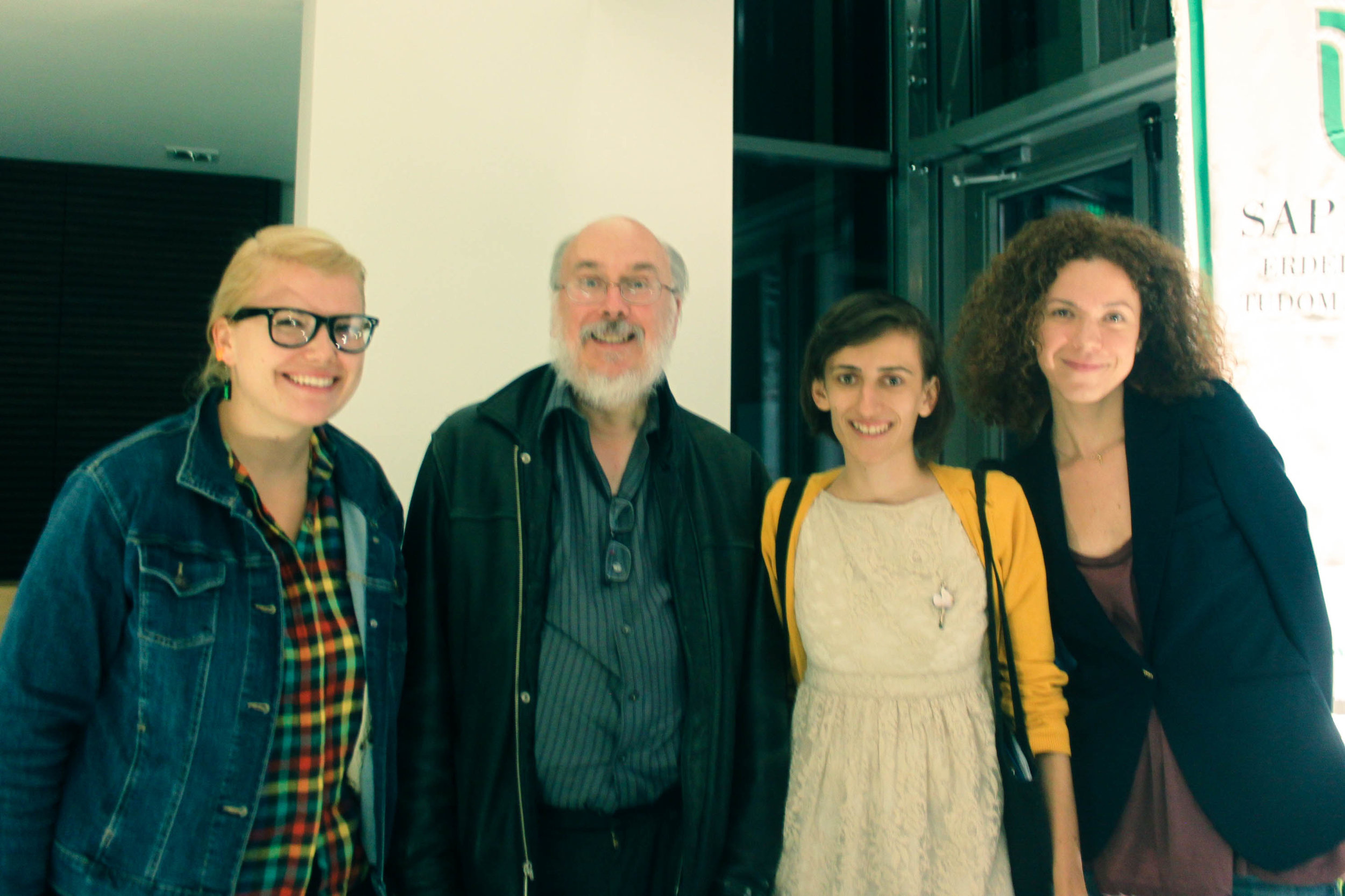 From Left to Right, these are Hannah Wolf, an American playwright visiting Bucharest on a Fullbright Scholarship; Ioana Mische ,a screenwriter who did an extensive interview with me about the concept of transmedia; and Ioana Drecin, a theater critic and scholar who was nice enough to lend her expertise to the planning of our grand Romanian adventures. I also spent a great deal of time at the conference with Anne Kustritz, an American fan scholar who now teaches television studies at the University of Amsterdam. But, I had great conversations with so many amazing researchers at this event. So, by the time we left on a wee hours flight, I felt I had acquired such a deeper understanding of both traditional and contemporary dimensions of Romanian life, and I will recall my time there with enormous fondness. These last few photographs are provided to me by Ioana Mische.
From Left to Right, these are Hannah Wolf, an American playwright visiting Bucharest on a Fullbright Scholarship; Ioana Mische ,a screenwriter who did an extensive interview with me about the concept of transmedia; and Ioana Drecin, a theater critic and scholar who was nice enough to lend her expertise to the planning of our grand Romanian adventures. I also spent a great deal of time at the conference with Anne Kustritz, an American fan scholar who now teaches television studies at the University of Amsterdam. But, I had great conversations with so many amazing researchers at this event. So, by the time we left on a wee hours flight, I felt I had acquired such a deeper understanding of both traditional and contemporary dimensions of Romanian life, and I will recall my time there with enormous fondness. These last few photographs are provided to me by Ioana Mische.




